Text
Nihon no Fuyu
This song samples ‘Sakura Dorops’ by Aun J-Classic Orchestra. To avoid copyright issues, I played the melodies myself and added processing in order to make it more unique sounding. It is in the key of G Minor and the time signature is 85bpm.
Oriental instruments present are Japanese ones including Koto and Shakuhachi.
The hi-hats were set to half speed at different points on the song in order to add variety to the beat and create space between sections of the song. This was done with the midi transform tool:

Multiple instances of Vinyl have been applied in addition to the crackles for a rich lo-fi texture:


Automation was implemented to add movement and variety to the mix.





0 notes
Text
Qi gong
This song is more upbeat compared to other songs on my album. It has a key signature of D pentatonic and a time signature of 85bpm.
Lots of lofi processing has been incorporated. For instance, the zither has a retro sound due to tape cassette:

The piano and Erhu are also run through tape plugin Vinyl:
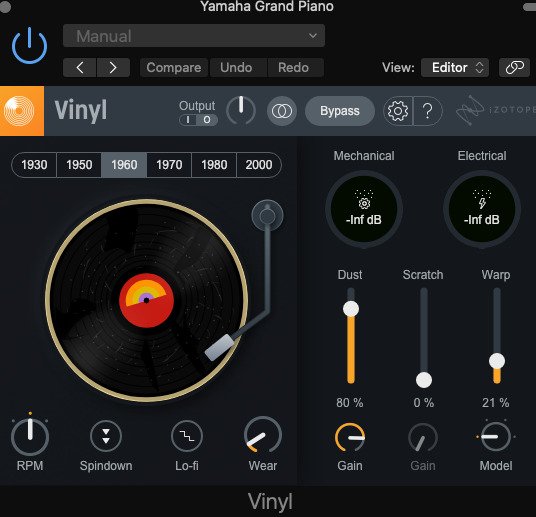

Automation consisted of panning:

In addition, to add some rhythmic flavour I added turntable scratch effects with Logic’s Remix FX:

Turntable scratch sounds can be heard in lo-fi beats especially those with a boom bap sound such as Free Flow Flava.
0 notes
Text
Edo
This track has a slower time signature of 80bpm. It is in the key of D pentatonic. Traditional instruments are Japanese.
In addition to previously mentioned lo-fi plugins and techniques, I applied this bit crusher plugin

A delay was applied to the piano for a more atmospheric vibe.
Automation
I automated the vinyl spin down effect to add to the lo-fi boom bap aesthetic. This is inspired by the lo-fi production of Free Flow Flava.

In addition, EQ automation is applied to the Hi-hats during the bridge of the beat.
Reference Track(s): ‘Stay Vision’ - Doubutsu System has a similar sound with the strings and laidback vibe.
0 notes
Text
Haiku
Key: It is in E pentatonic but can also be classed as Yo scale in D (D, E, G, B, D, A)
Time signature: 100bpm
This song doesn’t incorporate drum samples but VI from Logic which I added processing to make it sound more Lo-fi. This included previously mentioned tools such as EQ, bit crushing and retro reverb.
I applied tape emulation with Izotope Vinyl to provide an authentic lo-fi aesthetic, emulating the Guzheng being played on a record player.
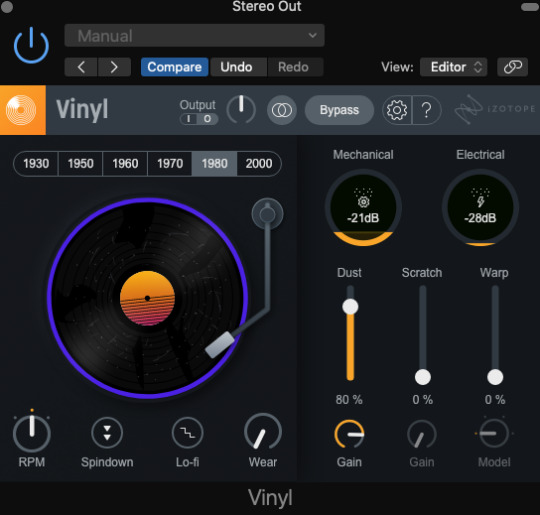
Automation involved volume variation and a filter making the drums sound even more lofi.

0 notes
Text
Commercial Aspects
The release of the album should occur in around 1 to 2 months. It is not advised to just put an album out there without other essentials such as a website, promotion plan, and artwork. Before releasing the album, I need to have an up to date website, Spotify profile, and social media pages ready.
Artwork
After completing my album, the next thing to complete is the artwork. This is for the album cover, my artist logo, but could also be for promotion such as art for my website and social media pages. As I know the importance of artwork in music, I didn't want to use any template and instead am hoping to have original and professional artwork for my album be produced by an artist. Although the artwork is still to be decided, I have some ideas. The concept is a Samurai sketched in a Comic style, similar to the album covers of Free Flow Flava - Ninja 404, and Fujiwara - Exyz.
Website
The website can be utilised to promote my album and other musical services. One way of promoting the album through the website is to have a mailing list. In addition, blogs related to my music, and musical topics can be written on the website.
Distribution
Once the artwork is complete, I plan to distribute the album through Ditto, an indie distributor. This way, I can obtain 100% of royalties without the need for a label. Overall, lo-fi tends to be independent producers, and so the need for a label isn’t great. The music is mostly in digital format and for this album I am going for this approach however for future albums I might utilise Vinyl.
Promotion
One of the ways of promoting the album is to send music to a Spotify playlist. At least two weeks before the release date, I can send a single from the album to a playlist to increase awareness of the album.
0 notes
Text
Tai Chi
Production Aspects:
Key: A pentatonic
Time signature: 90bpm
A different reverb was applied to the piano to provide an atmospheric vibe:

Automation of volume present but also panning of flute to provide a better sense of space and add variety to the mix.

Oriental instruments were mostly processed very transparently with EQ, however more processing was applied to the Chinese Guitar so that the lo-fi texture of the song is present without affecting the traditional sound much.


0 notes
Text
Suzhou
This composition is melancholic and laid-back, drawing on elements from traditional Chinese music and Jazz. The chord progression is Western, fused with Oriental melodies to innovate the sound of lo-fi, whilst maintaining a balance between East and West. Nujabes is known for Jazz inspired lo-fi, however his music lacks traditional Oriental instruments. I think the fusion of Jazz and Oriental aspects is a unique sound that works well in the context of lo-fi.
Key: A pentatonic
Time signature: 90bpm
The sound palette and processing is similar to other songs on the album, however I have added an Electric Piano rather than just an acoustic piano to add variety to timbres present in my album.
Automation consisted of panning and volume variations, but I also utilised automation to vary timbres:

Muddiness was avoided by panning instruments with presence in similar frequencies in opposite directions:

0 notes
Text
Yuan Xiao
This song represents the traditional Chinese festival Yuan Xiao; Chinese New Year. It is a more lighthearted and upbeat song. This is demonstrated by the beats shaker pattern, the articulation of the Zither and chill piano. The Guzheng has tremolo articulation. This tremolo sound can be heard on other Oriental Lo-fi songs. Here is an example track:
https://open.spotify.com/track/3jF3mBBHWUpOyvsCB2tbVV?si=2fa3c45e9d9d4a64
A variety of traditional Oriental sounds have been incorporated in order to depict the traditional festival full of East Asian culture. However, there is also a Jazzy aspect to the track, particularly the piano.
In addition, the swing of the beat can be heard in the shaker which is inspired by J Dilla’s beat production process.
Key:A pentatonic
Time signature:90bpm
Mixing
Yuan Xiao has a similar sound palette to Chanoyu. However the drums are processed to sound slightly different. For instance, the click is filtered to give a more lo-fi sound:

In addition, the main snare didn’t sound that lo-fi at first so adding some saturation helped produce a lo-fi sound:

Sidechain compression was incorporated across most instruments.
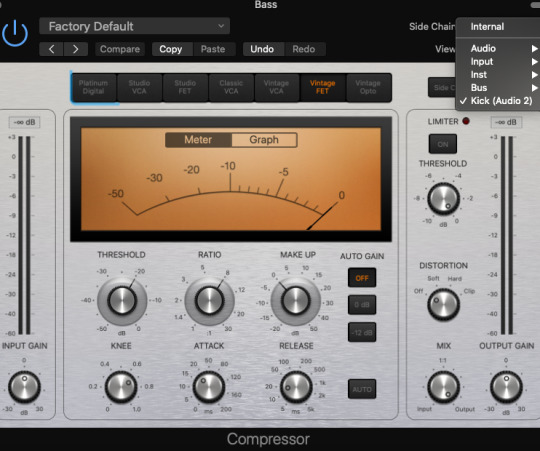

Traditional oriental instruments weren’t processed much however some distortion was applied to add to the lo-fi texture:

0 notes
Text
Road to Kyoto
This song is about a Samurai travelling a long distance to Kyoto. The mood is more solemn and the erhu’s articulation is a key element demonstrating this with its vibrato articulation, melody, and presence in the mix. The automation of volume at the beginning represents the long distance the Samurai has been walking. The flute adds a more positive vibe to the song, as although the journey is a long one, the Samurai maintains a calm focus.
Key: A pentatonic
Time signature:90bpm
Mixing
Lo-fi plugins include Vinyl by Izotope applied to the Koto. The year setting was 1930′s, giving the Koto a more lo-fi sound with increased distortion and reduced low and high end frequencies.

0 notes
Text
Chanoyu
This track represents Herbal Tea and its associated tea ceremony; something which is an Ancient practice in Japan and was part of the Samurai’s way of life.
Chanoyu is the Japanese word representing tea ceremony.
The variations in the loudness of crackles result in varying texture to the composition. This can be compared to the varying textures of the tea made. Variation in vinyl crackle can be heard in DJ Grumble’s music. Although not Oriental Lo-fi, DJ Grumble is a Hip Hop producer who often incorporates a lo-fi aesthetic.
https://open.spotify.com/track/0IavlEH3R52pNQg7iTk2MQ?si=ce499fbe7db24118
The drums are different to the previous songs, with the click and filtered snare providing a warm but crisp vibe, similar to that of herbal tea.

Chanoyu is in the key of A pentatonic and has a time signature of 90bpm.
Mixing
This song has less processing applied yet still maintains a lo-fi sound.
Automation of volume, EQ, and reverb was applied:


0 notes
Text
Moonlit Dojo
Moonlit Dojo represents practicing martial arts in a scenic setting, such as one found in a Kung Fu or Samurai movie - an Ancient Dojo with the full moon shining over it. This song incorporates the Pipa, in addition to previously heard Chinese instruments.
This song is in the key of A pentatonic and has a time signature of 90bpm.
The Erhu utilises the same articulation which to western ears sounds like a pitch bend. This can be heard in ‘Sekigahara no Tatakai’ by Vindu.
https://open.spotify.com/track/0syTv4NZo8EFhyBGyH9qS1?si=b1bca1d279894761
The use of Asian percussion such as the gong can be heard in ‘Nagato’ by DaniSogen. This is also commonly associated with Kung Fu and can be heard in songs by Free Flow Flava such as Mugen Ryu Heiho.
https://open.spotify.com/track/4Hd4XO0uRXRnoOIBfmHKPX?si=b936adeade794f90
https://open.spotify.com/track/2nzRaEiIzP6qGigQb6m02D?si=f1ea59a1703b4fae
Mixing
Lo-fi Plugins:

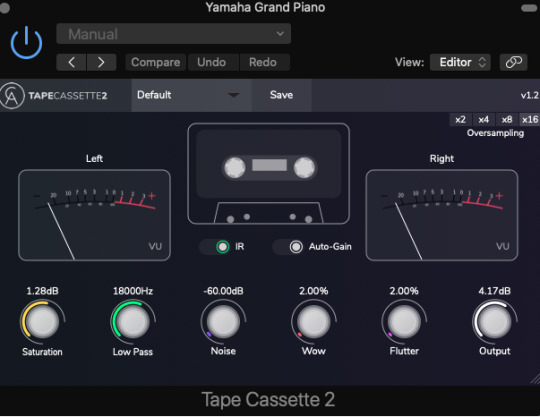
To add depth to my beat, I added a delay to the snare.

Automation
Automation consisted of volume variation in order for the song to add dynamics to the mix. Filtering of frequencies during the bridge and outro adds movement to the song and when high frequencies are filtered the mix sounds even more lo-fi whilst allowing other aspects of the mix to have more presence. This technique can be heard in other lo-fi songs such as ‘First Snow’ - Kerusu
https://open.spotify.com/track/4okFdEte6SmTcGYuemlqAS?si=a5ddaafee5254268
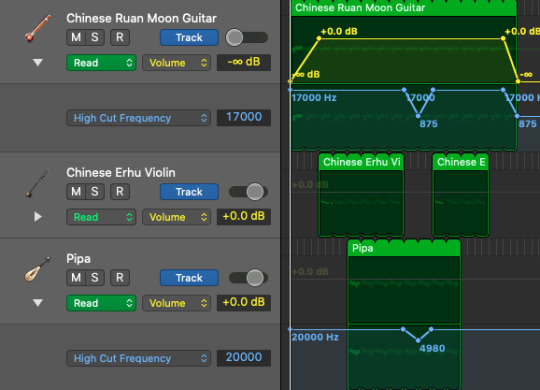
I also implemented panning in order to add variety and create a sense of space within the mix.

0 notes
Text
Sakura Breeze
Concept
This song represents Sakura or blossoms in English. A common theme within Oriental Lo-fi, and traditional Japanese music. For instance one of the most famous traditional Japanese songs is ‘Sakura Sakura’ which incorporates the Koto as its main melody.
https://open.spotify.com/track/6XuexEK4Ir6jiC6Sy38uG5?si=bcb14af16d5e4a11
Arrangement

Drums were layered to add variety.
The piano providing harmonic accompaniment by playing Jazz inspired chords such as 7ths. There is a mellow mood, supported by the expressive capabilities of the traditional instruments, particularly the Erhu. An emphasis on melodies harmonising well together to create a calm atmosphere is inspired by traditional Oriental music, which has multiple melodies which flow elegantly throughout. The Koto melody has articulation similar to that used in songs such as ‘Japanese Spring’ by Vindu.
https://open.spotify.com/track/0JORICZG7cvBoHVEUHiUK3?si=91e914e58c9640e5
Also, it is worth noting that the Koto is often associated with Sakura and spring, so it seems appropriate to use this instrument in this composition. The song is also in the key of A pentatonic and has a tempo of 90bpm.
Reference tracks: this song is inspired by the likes of Nujabes, particularly the mellow mood and use of flute to create a soothing tone to the song. Here is an example: ‘Dawn on the side’ - Nujabes
https://open.spotify.com/track/764QZXmgb5fDwh1NU8pYcd?si=c4a7a08ea95f4401
Mixing

This plugin adds punch to the kick.

Tape emulation was applied to the piano for a lo-fi aesthetic
Automation consisted of volume changes.
0 notes
Text
Spiritual Samurai
Concept
My first track depicts a Samurai preparing to embark on a journey throughout the Orient.
Arrangement
Japanese and Chinese instruments used include Koto, Guzheng, Shakuhachi, and Erhu. Articulation of the Erhu provides a distinct Oriental sound which isn’t heard in Western musical instruments. Lo-fi drums were utilised from sample packs, where I created my own drum pattern from. In addition, I included Asian percussion to provide a more authentic Oriental atmosphere.

Compositional/Production Aspects
I have based the melodies around pentatonic scale in A (A, C, D, E, G). It has a time signature of 90bpm. In terms of structure, reverse crashes help to glue sections of the song together. This is from a trap sample pack and is inspired by Trap beats that use it, including Japanese trap. Here is an example of a song incorporating this: ‘Hidden Path’ - Free Flow Flava
https://open.spotify.com/track/6ngNjGO6N2z5Usgr3GH2tE?si=8a61d112251b4f86
I used some plugins to add to the lo-fi sound and create a sense of space within the mix. For instance, bit crusher, retro reverb, and analog style compressors. The use of EQ to filter high frequencies in elements in the mix has been useful in producing a lo-fi aesthetic.
Mixing
There are sounds and effects I incorporated to achieve a lo-fi aesthetic. For instance, I utilised side chain compression on the vinyl crackle so that each instance the kick is present, the crackle is compressed. This is a classic lo-fi technique. Lo-fi side chain compression settings tend to be easy to hear. in order to achieve this ‘ducking’ sound, I set a high ratio, quick attack and release, as well as a low threshold. “ For an exaggerated use of the effect, you might push your ratio to something drastic like 18:1, limit your attack to next to nothing, set a short release, and push your threshold far down to something like -30 dB.” [samplified]

Bitcrushing was applied to some aspects of the mix.
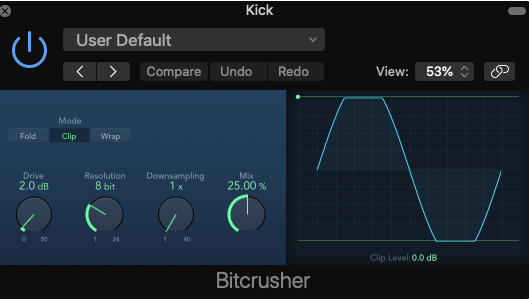

Distortion and saturation has also been incorporated to add depth to the mix:
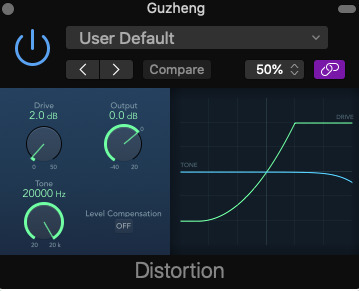

Furthermore, to provide a sense of space to the mix, I applied ‘Tal Reverb’, a retro sounding reverb, as well as panning certain instruments in order for there to be a sense of depth to the mix.


Automation
This consisted of volume and panning variations:


1 note
·
View note
Text
Oriental Lo-Fi Overview
Oriental Lo-Fi can be described as a sub-genre within the Lo-fi Hip Hop musical genre. It is the fusion of traditional Oriental music and lo-fi beats. In order to understand its key characteristics, I have researched traditional Oriental music and Lo-fi music separately, due to the lack of resources on Oriental Lo-fi specifically.
Key Characteristics
Traditional Oriental Instruments
Laid-back beats
lo-fi sound design
Ambience
Emphasis on mood
Traditional Oriental instruments often utilised in Oriental Lo-fi include Japanese ones (Koto, Shamisen, Shakuhachi etc. ) more so than Chinese ones, however I want to incorporate both as I appreciate the instruments from both cultures, and due to their similarities, I think they sound well together. I will discuss the Oriental instruments I will be using in my album.
Traditional Chinese instruments include:
Erhu: a bowed string instrument, known as the Chinese two stringed fiddle. This instrument is a favourite of mine due to its versatile level of expression.
Guzheng: an ancient plucked string instrument with 21, 25, or 26 strings.
Pipa: a pear-shaped, four stringed plucked instrument.
Dizi Flute: A Chinese bamboo flute, which is found in a variety of Chinese music.
Zither: Also known as Guqin, this is a plucked seven string Ancient instrument.
Chinese Moon Guitar: Known as a Yueqin guitar, this instrument is another four stringed plucked instrument, however it has a different look and sound compared to the Pipa.
Traditional Japanese instruments include:
Koto: an ancient thirteen stringed plucked instrument, which is one of the most popular traditional Japanese instruments.
Shakuhachi: a woodwind instrument that was first used in Gagaku ensemble music.
Laid-back beats
J Dilla is often regarded as the most influential producer, alongside Nujabes, who set the tone for modern lo-fi beats. He played his beats in a loose fashion that gave them a unique swing. Lo-fi beats are usually offbeat. Boom Bap beats are mostly incorporated, however lo-fi trap is a style of lo-fi incorporating trap style beats that are processed to have a lo-fi aesthetic.
Bass element tends to consist of a sub-bass, however acoustic Jazz bass can be heard, particularly in Jazzhop. The instruments vary depending on the style. For instance, Jazzhop incorporates more Jazz instruments, such as piano, saxophone, and harp. Whereas lo-fi trap might incorporate more synths. Atmospheric and melancholic sounds can sometimes be incorporated across lo-fi beat styles, such as acoustic guitar and synth pads.
Lo-fi sound design involves:
Saturation, which can be achieved in the form of tape emulation plug-ins
Bit-crushing, which is a form of digital distortion enabling downsampled sounds to provide a nostalgic vibe.
Vinyl crackle which tends to be from sample packs, but can also be incorporated by recording beats to a tape cassette.
Ambience and emphasis on mood
Field recordings/foley samples that tend to include sounds of nature, which matches the themes of Oriental Lo-Fi beats.
Vinyl crackle is an essential part of lo-fi sound design but it is also very beneficial in creating a warm retro atmosphere.
Conceptually, Oriental Lo-fi albums tend to be based around Japanese culture, cities, and nature. Artwork and song titles often have a Samurai or Japanese landscape.
Key Artists
Artists specialising in Oriental Lo-fi include DaniSogen, Vindu, and Nogymx. I wanted to know if these artists were sampling traditional Oriental songs, just how most lo-fi/Jazzhop producers sample Jazz songs. Some of the songs I have listened to definitely sample Oriental music whereas with some it is difficult to tell as there is almost no information regarding this. One way of assisting in determining if beats use samples is the site Whosampled. This showed that Saib, a well known lo-fi producer had sampled a Japanese song ‘Haruyo Koi’ by Aun J-Classic Orchestra on his well known ‘Shanghai Nights’.
Other Songs With Samples:
‘Eternal’ - Free Flow Flava (samples ‘For the world’ from Hero OST).
0 notes
Text
Introduction
Welcome to my Oriental Lo-Fi project. Throughout this series of blog posts, I will be discussing Oriental Lo-Fi, my album, and the process involved. Firstly, I will provide an overview of Oriental Lo-Fi, including its background, key characteristics, and notable artists. Then, I will discuss my Album, including aspects of production, concepts, and key artists. Once my album is complete, I will discuss the mixing and mastering ideas. In addition, a distribution and promotion plan will be included.
0 notes